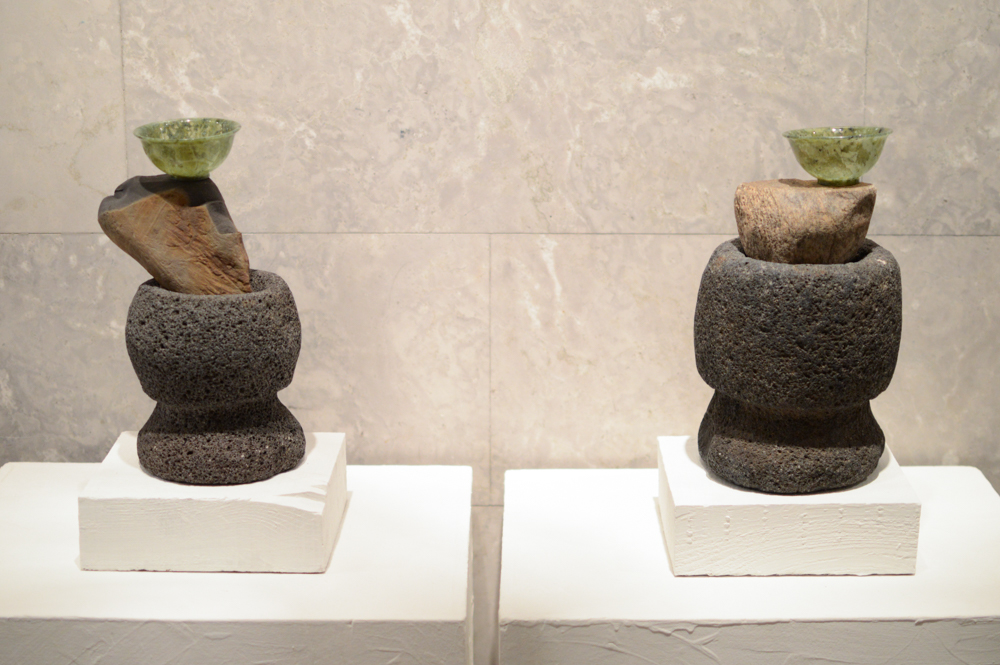Former Concordia student and artist Ari Bayuaji recently finished a residency at the MMFA
“The museum is the reunion of so many objects from all over the world,” said Ari Bayuaji. The Indonesian artist just finished a residency at the Montreal Museum of Fine Arts (MMFA), which inspired the works in his current exhibition titled A Cabinet of Curiosities.

In order to be considered for the artist-in-residence position, Bayuaji had to submit a project proposal. He decided to explore the relationship between art and design. Having previously worked as a designer, the topic was one of particular interest to the artist. Bayuaji said that since moving to Montreal, he has noticed the quality of manufactured materials and goods in North America is low compared to other parts of the world, such as Europe. The artist said this was one of the reasons he chose to study fine arts rather than design when he applied to Concordia. He attended the university from 2005 until 2010, when he decided to discontinue his studies and pursue artistic endeavours outside the classroom.
During his time at the MMFA, Bayuaji took full advantage of the resources made available to him and completely immersed himself in the museum’s collections. He drew significant inspiration from the Archaeology and World Cultures collections, and studied pieces from Egypt, Asia and Islamic countries.
“It was quite freeing,” the artist remarked in reference to the wealth of information and artwork he was able to access at the museum.
Bayuaji also made connections between the museum’s collection and today’s globalized society. Just as the museum houses objects from across the globe, he said, the same could be said of the contemporary world. People are able to immigrate to other countries and, therefore, spread their culture and art with people they wouldn’t have been able to connect with at other points in history, the artist explained.

That being said, through archaeology and agriculture, foreign objects have been found in unusual places. According to Bayuaji, in Indonesia, farmers would often find pieces of foreign objects buried in their land. They believed these objects had a sacred quality and would often wear them as necklaces or bracelets. Bayuaji takes a similar approach and collects objects he finds on the street and in his travels. He then “elevate[s] those pieces into sacred objects” by featuring them in his art. Through sculpture and multimedia, the artist incorporates his everyday findings, thereby establishing the objects as noteworthy and special.
Bayuaji claimed his artistic practice is informed by both his upbringing in Indonesia and his exposure to Western culture before and since moving to Montreal. He said he hopes people of all origins can identify with something in his work. By deconstructing objects with cultural and historical significance, Bayuaji’s work also aims to deconstruct his as well as others’ identities.
His interest in reusing found objects and presenting them in a new context led to the idea of a cabinet of curiosities while working at the MMFA. Cabinets of curiosities, according to the British Library’s website, “were small collections of extraordinary objects which, like today’s museums, attempted to categorize and tell stories about the wonders and oddities of the natural world.” Bayuaji explained they were common in wealthy households of 17th and 18th century Europe. Inspired by the idea, and also by the MMFA’s Cabinet of Curiosities collection, the artist determined that these ‘cabinets’ would be instrumental in displaying his pieces.

Each piece in A Cabinet of Curiosities has clear intention, as if demanding a certain amount of respect from its viewer. Objects are placed on pedestals, in frames or in old cabinets. The piece titled Trésor consists of pieces of broken ceramic that have been placed inside a small glass vase. The vase has been put on a marble plate and is encased in a clear, glass cloche. Though the broken ceramic may suggest uselessness or damage, by presenting it with prestige and honour, Bayuaji begs the viewer to reconsider its function. The artist also emphasized that finding beauty within his pieces is an important aspect of the viewing experience.
The artist’s honouring of deconstructed, everyday objects can be seen in the piece titled Scholar Stone #1 & #2 as well. Two pieces have been placed beside each other and are almost identical. Large stone mortars (as in a mortar and pestle) sit atop wooden pedestals. In the mortars sit brown rocks, about the size of a foot. Delicate jade bowls sit atop the rocks, somewhat precariously placed. The viewer is captivated by both the precariousness of the sculpture and the beauty that is conveyed in a few simple components.
On the opposite wall of Trésor and the Scholar Stone(s) hangs Alternative Wall. This piece is made of old cotton money bags, which have been sewn together to make a large quilt-like hanging. It is striking against the rest of the exhibition, due to its size and medium. A variety of stamps and logos brand the bags, calling attention to the utility of the pieces, while the artwork in its entirety is visually impressive.
A Cabinet of Curiosities explores a variety of media and shapes, and takes the viewer on a pleasantly stimulating journey around the upper level of the Maison du Conseil des arts de Montréal (1210 Sherbrooke St. E.). The exhibition will be on display until April 2, on weekdays from 9 a.m. to 5 p.m.
Photos by Mackenzie Lad




